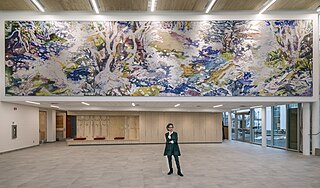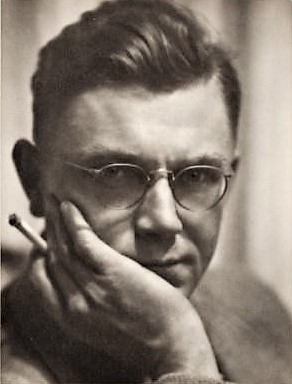
Jean-Paul Riopelle, was a Canadian painter and sculptor from Quebec. He had one of the longest and most important international careers of the sixteen signatories of the Refus Global, the 1948 manifesto that announced the Quebecois artistic community's refusal of clericalism and provincialism. He is best known for his abstract painting style, in particular his "mosaic" works of the 1950s when he famously abandoned the paintbrush, using only a palette knife to apply paint to canvas, giving his works a distinctive sculptural quality. He became the first Canadian painter since James Wilson Morrice to attain widespread international recognition and high praise, both during his career and after his death. He was a leading artist of French Lyrical Abstraction.

Betty Roodish Goodwin, was a multidisciplinary Canadian artist who expressed the complexity of human experience through her work.
Fernand Toupin was a Québécois abstract painter best known as a first-generation member of the avant-garde movement known as Les Plasticiens. Like other members of the group, his shaped paintings drew upon the tradition of geometric abstraction, and he cited Mondrian as a forerunner. In 1959, Toupin began working with a more lyrical, though abstract, way of painting. The last decade of his career saw his return to geometric abstraction. Like Jean-Paul Mousseau, Toupin created works which lay outside the standard boundaries of art such as his stage sets for ballets.
Bill Vazan is a Canadian artist, known for land art, sculpture, painting and photography. His work has been exhibited in North America and internationally.
BGL is a Canadian artist collective composed of Jasmin Bilodeau, Sébastien Giguère and Nicolas Laverdière. The artist collective have been active since 1996 since completing their studies together at Laval University in Québec City, Canada.
Jennifer Hornyak is a Canadian artist known for her semi-figurative style. Early in her career her scenes of Montreal personalities were exhibited at the 1987 Paris World Exhibition. She is now recognized for her colourful and textured graphic still lifes.

Jewish Painters of Montreal refers to a group of artists who depicted the social realism of Montreal during the 1930s and 1940s. First used by the media to describe participants of the annual YMHA-YWHA art exhibition, the term was popularized in the 1980s as the artists were exhibited collectively in public galleries across Canada. In 2009 the Musée national des beaux-arts du Québec mounted a touring exhibition Jewish Painters of Montreal: A Witness to Their Time, 1930–1948, which renewed interest in the group in Montreal, Toronto, and Vancouver.

Kathleen "Kay" Moir Morris was a Canadian painter and although not an official member of the Beaver Hall Group, she often is counted as a member since she was friendly with many of its members and exhibited with them.
Nancy Petry is a Canadian artist known for innovation within the field of painting, photography, film and performance art. As one of the first Canadian artists to paint in the style of lyrical abstraction, her work was featured at the Commonwealth Institute, at the Musée d'art contemporain de Montréal and in a National Gallery of Canada touring exhibition. She was also instrumental in establishing the Association des graveurs du Québec and contributed to the success of the Montreal alternative art cooperative, Véhicule Art. In 2015 the "Nancy Petry Award" was instituted.
Peter Krausz is a Romanian-born Canadian artist. Throughout his career, he worked within the fields of painting, drawing, installation, and photography and, since 1970, exhibited in museums and galleries across Canada, the United States, and Europe. He is best known for large-scale landscape paintings of the Mediterranean.

Kevin Sonmor (1959) is a Canadian artist known for paintings of still lifes, equine and marine scenes. A postmodernist, Sonmor blurs the boundaries between contemporary abstract landscape and historic landscape traditions by creating a visual language which is both representational and symbolic. His work is exhibited in public and private galleries across North America and in Europe.
Michael Flomen is a self-taught Canadian artist who primarily creates photograms, or cameraless photographs in collaboration with nature. Flomen began taking photographs in the late 1960s, and since 1972 his work has been exhibited internationally. Snow, water, firefly light, wind, sand, sediment, shorelines and other natural phenomena make up the elements used to create his photograms.

Susan G. Scott is a Canadian artist known for both contemporary figurative painting and, more recently, her landscapes. Her work is found in national and international public collections including the Canada Council for the Arts, Musée national des beaux-arts du Québec, Musée d'art contemporain de Montréal, Art Gallery of Nova Scotia, Collection du Fonds régional d'art contemporain d’Île-de-France in Paris, Canada - Israel Cultural Foundation in Jerusalem and Houston Baptist University in Texas. She was elected to the Royal Canadian Academy of Arts (RCA) in 2013.

Philip Surrey LL. D. was a Canadian artist known for his figurative scenes of Montreal. A founding member of the Contemporary Arts Society, and Montreal Men's Press Club, Surrey was part of Montreal's cultural elite during the late 1930s and 1940s. In recognition of his artistic accomplishment he was elected to the Royal Canadian Academy of Arts, awarded a Canadian Centennial Medal in 1967 and was appointed to the Order of Canada in 1982.
Nell Tenhaaf is a Canadian artist, teacher, writer and feminist.
Ricardo L. Castro, is a Colombian-born, Canadian architectural photographer, critic, and educator. Known for his monographs on architects Rogelio Salmona and Arthur Erickson, his design philosophy was published in Syndetic Modernisms (2014). Castro was elected Fellow of the Royal Architectural Institute of Canada (FRAIC) in 2010, and to the Royal Canadian Academy of Arts in 2015. He was awarded the 1990 Prix Paul-Henri Lapointe for architectural journalism by the Ordre des Architectes du Québec. A frequent contributor to Canadian Architect Magazine and ARQ Architecture Québec, photographic expositions of his work were also held in public institutions in Bogotá, Vancouver, Toronto, Ottawa, Montreal and Quebec City.

Richard-Max Tremblay is a Canadian artist and photographer. Known for painting and photographic portraits, Tremblay's artistic approach is described as "a dialogue between two media, photography and painting". He is the recipient of the Royal Canadian Academy of Arts' 2015 RCA Trust Award, the 2003 Prix Louis-Comtois, and, as cinematographer of Gugging, the 1996 Special Jury Prize, International Festival of Films on Art and Pedagogy. Tremblay's work is found in the collections of the Montreal Museum of Fine Arts, Musée national des beaux-arts du Québec, Musée d'art contemporain de Montréal, Musée d’art de Joliette, the City of Montreal and the Canada Council for the Arts' Art Bank.
Jean Albert McEwen was a Canadian painter known for his lyrical abstraction.
Gordon Webber was a multimedia pioneer of modernism in Canada. He was also an educator.
John Richard Fox was a painter, sculptor, collagist, watercolourist and draftsman, as well as an educator who lived in Montreal most of his life. His work beginning in the late 1950s moved easily from representation to abstraction in 1972 and in 1986, back again to representation. He regarded the two different aspects to his work as having the same concerns. He was often praised as a colorist and for his rich surfaces and subtlety of effects, even in his abstract work. As has been recognized increasingly since the 1990s, Fox’s paintings and particularly his abstractions are a valuable part of Canadian modernism.







